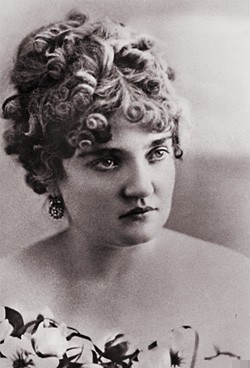Yates Martin (Edward G. Robinson) is a Kansas farmer with dreams of making it big. He moves from town to town, and according to his wife Sarah (Aline MacMahon), is elected mayor in each town… but doesn’t stay long enough to make anything of himself.

When Yates gets the idea to join the silver mining business, Sarah insists he opens a store as a back-up operation, not wanting to send the family into financial ruin over failed mines. He agrees, but his mining greed gets in the way of the store’s success.
Finally, Yates gets a break when he becomes a partner in a very successful mine. He makes quite a bit of money, and finds his way into politics. But with wealth comes personal complication. With his marriage in turmoil, Yates turns to a pretty, young blonde named Lily (Bebe Daniels), who is all too happy to benefit from her new beau’s wealth.
Alfred E. Green directs 1932’s Silver Dollar, inspired by the real-life story of mining tycoon Horace Tabor.
Silver Dollar is a disappointment when you learn the real story of Horace Tabor and his second wife, Elizabeth “Baby Doe” Tabor, but before I get into that I’ll make a few notes about the film, as viewed before learning its inspiration.
It started with a laugh for me as Edward G. Robinson appeared on-screen in cowboy garb and a mustache — a far cry from the big-city gangster suits I’m used to seeing him wear. It took me a minute to get used to the sight of Edward G. in Western costume, but once I did, I found his performance to be very fine, as usual. Robinson is particularly good in the film’s final half hour or so, when things begin to go downhill for Yates.
Yates Martin is a scheming fellow whose schemes finally begin to pay off, despite his wife’s protests that they should just pack up and head back to Kansas. He’s a terrible husband and a stubborn man, determined to do things his way or no way, which doesn’t exactly endear him to the audience. Though I was no fan of this man, Robinson still brought some very effective emotion to the character in that final act.

Aline MacMahon also gives a very good performance as Martin’s long-suffering wife. She speaks up to him and has a do-it-yourself, independent attitude, but also feels kind of hopeless in her marriage. Martin comes to spend so little time at home, and it clearly hurts her, though she’s a strong woman. MacMahon evokes a lot of sympathy for Sarah.
Silver Dollar is part martial drama and part political drama as Martin works his way into a position of power in the government. This sounds like it should be fascinating, but despite a few good performances, the film on the whole falls flat. I was disappointed by it, and became even more disappointed after reading about the true story that inspired it, “Baby Doe” Tabor’s life in particular.

Baby Doe was once-divorced herself when she struck up an affair with Horace Tabor, a man many years her senior and married to another woman. When Horace left his wife to marry Baby Doe, they lived in wealth, though their relationship caused a great scandal. In a true “rags to riches” story, Baby Doe became a millionaire by marriage, and her husband even served as a senator for a time.
When the silver market went bust several years later, Horace made some bad business decisions and drove himself into financial ruin. He and Baby Doe lost everything, and he took a job at a mine for just $3 per day.
Horace died in 1899, but Baby Doe lived for over 30 years after he passed. Unfortunately, her life didn’t improve. Along with his wife, Horace left behind their two daughters, neither of whom would have a very strong relationship with their mother.
Lily, the older daughter, left her mother to live with extended family and even went so far as to deny being Baby Doe’s daughter, later in life. Younger daughter Silver Dollar stayed with her mother for a while, and they lived in a shabby cabin at one of Horace’s old mine sites — the cabin where Baby Doe would live out the rest of her days.

With a wild streak just like her mother had expressed as a teen, Silver Dollar eventually moved to Denver, where she had a job writing for a newspaper but earned a reputation of being a drunk. She then moved to Chicago and got a room in a boarding house under a false name. She was found dead there, scalded to death — a tragic end for Baby Doe’s baby girl, though Mrs. Tabor would never admit that the 35-year-old woman killed in Chicago was her daughter.
With a life fit for a soap opera and a half, Baby Doe’s story is more than suitable for a Hollywood feature. Unfortunately, 1932’s Silver Dollar just doesn’t measure up to this dramatic roller coaster of a true story. Upon viewing the film I was underwhelmed by it, but after learning more about its inspiration, I’m downright disappointed that a better film hasn’t been made about the Tabor saga!
Wow, thanks for the review and the real scoop. I can see why you feel the film pales by comparison, and given that it’s a pre-Code film, we could have expected more.
LikeLike
Yeah, there was just so much more that could have been explored, especially if the focus had been shifted to Lily. None of her life after her husband’s death is explored, which to me is the most interesting (and heartbreaking) part of the real story. It’s just a case of wasted potential!
LikeLiked by 1 person